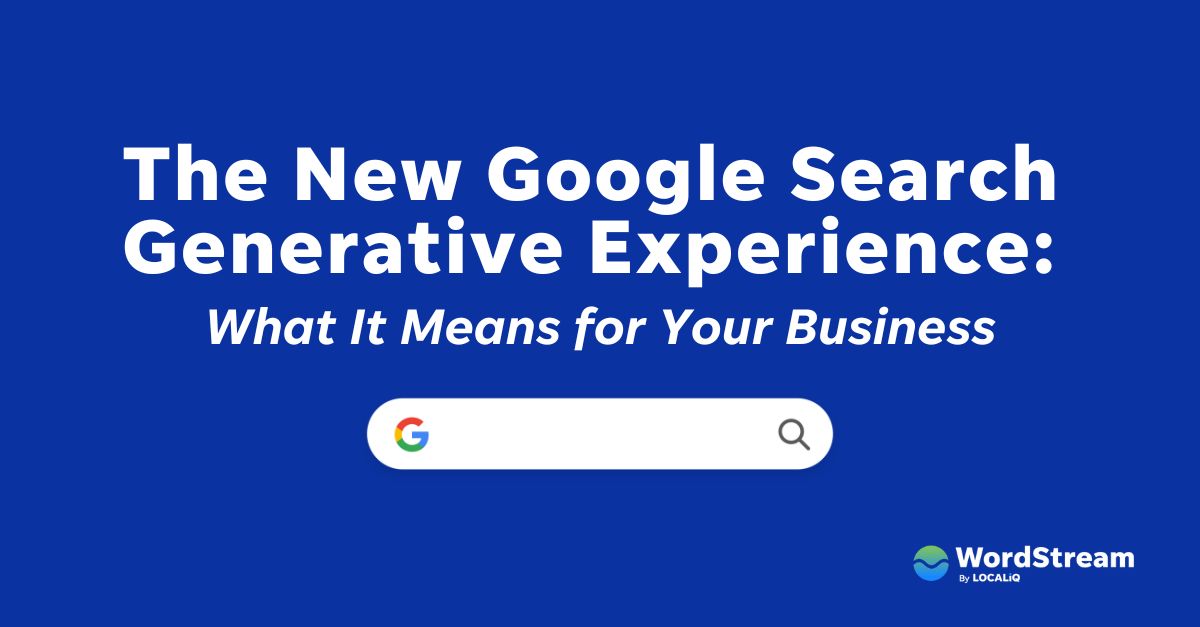Want to make a marketer nervous? Tell them there are big changes coming to Google search pages. So you might be wringing your hands a little since Google recently announced their AI-powered Search Generative Experience (SGE) is coming to shake up SERPs.
You’re probably asking lots of questions: Will AI-generated responses reduce site clicks? How will search ads perform on SGE pages?
We don’t have all the answers yet; SGE will be an opt-in experiment that evolves over time. But we can glean some important details from what Google’s told us already. The good news is that the world’s largest search engine says they’re still focused on driving traffic to websites and keeping search ads a “native part of SGE.”
Let’s take a look at how Google will make good on those promises and what SGE will mean for marketers and advertisers at businesses of all sizes.
What is Google’s Search Generative Experience?
SGE is an experimental version of Google’s search engine that uses artificial intelligence to generate contextual answers to complex questions.
There are three ways SGE uses AI to enhance the search experience:
- AI snapshot: Generates a unique summary for some longer queries
- Conversational mode: Answers follow-up questions while retaining the context of the original search
- Vertical experiences: Provides a preferred list of features and more product details in commercial searches
We’ll dive a little deeper into each of these pieces next.
What makes up Google’s Search Generative Experience?
While all of these features are meant to help people find better answers faster, they are also designed to encourage the exploration of online content.
AI snapshot
Ask Google how many visitors Bryce Canyon National Park gets every year and it’ll quickly present a trustworthy article that says 1.5 million. Now ask if Bryce Canyon or Arches National Park is better for families with young kids and a dog, and you’ll get a list of links that each answer part of your question.
SGE uses AI to generate a unique response to your multi-angle query, drawing information from several sources at once. Google calls this a snapshot.
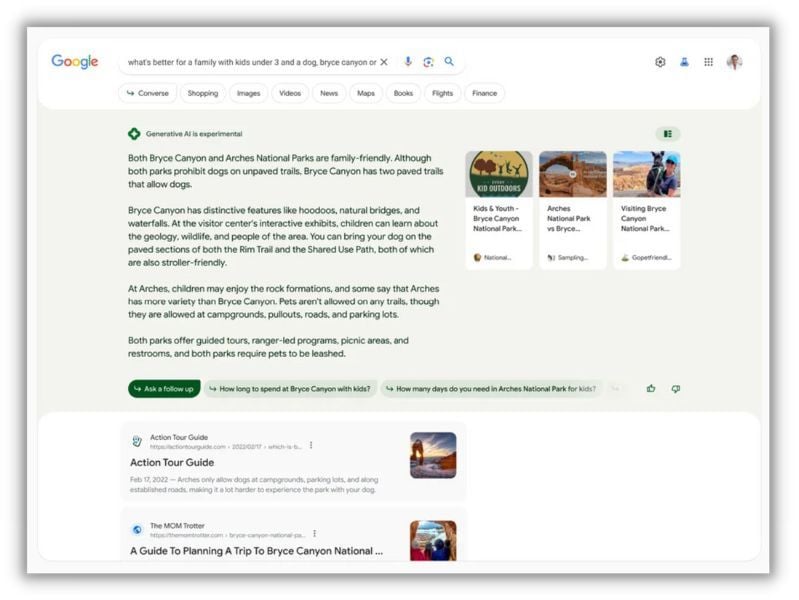
Source
The snapshot is designed to give a brief answer to very long-tail questions, like “what’s the best restaurant for a family with peanut allergies near the Empire State Building that doesn’t have a long wait.”
But SGE isn’t meant to answer your question and send you on your way. Google says its focus remains on driving attention to web content. “As we bring generative AI into Search, we’re committed to continue sending valuable traffic to sites across the web.” We see this as a hopeful sign for businesses that rely on paid or organic search traffic.
One way Google will keep the clicks flowing is by placing three links prominently to the right of each snapshot. They’ll have thumbnails to draw viewers’ attention.
Then there’s the icon Google affectionately calls the “bear claw.” It’s just above the three featured links. Click it and the snapshot expands, revealing the content that informed each sentence of the snapshot.
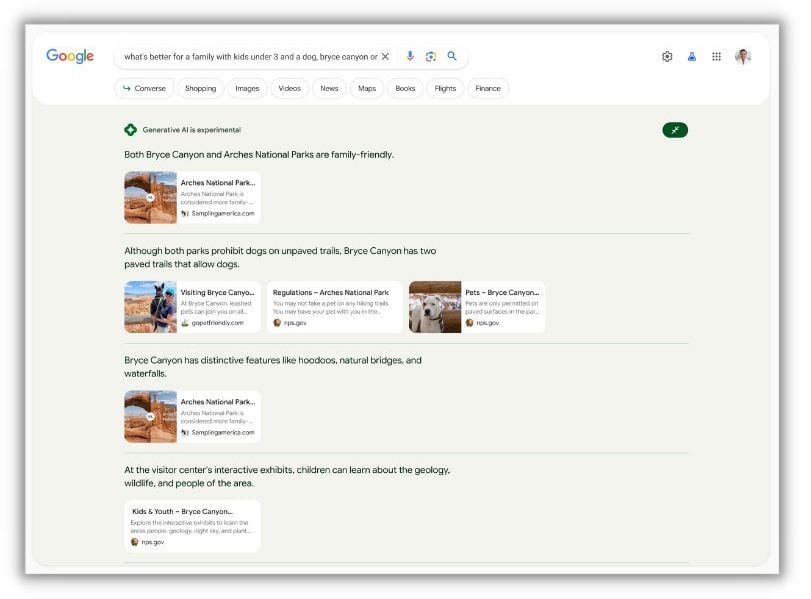
The added benefit to such transparency is trust. Every sentence is corroborated by an outside source. That’s important since other AI tools like Bard don’t have the best reputation for accuracy.
There are times SGE will decide not to offer a snapshot—for example, when it doesn’t have enough information, or for sensitive questions about finances or healthcare (YMYL—Your Money, Your Life—topics), you won’t see an AI answer.
The bottom line: SGE is a different search experience. And a changing SERP can lead to fluctuations in both paid and organic results and impacts on your rankings, traffic, and advertising costs.
Conversational mode
Google searches don’t always end after the first query. SGE’s conversational mode is designed to answer follow-up questions while maintaining the context of the search.
You engage conversational mode by tapping “ask a follow-up” or one of the suggested next steps under the snapshot.
Google’s Kathy Edwards recently demonstrated this feature live at Google I/O. After searching “why do whales like to sing,” Edwards followed up by typing “plush ones for kids under $40.”
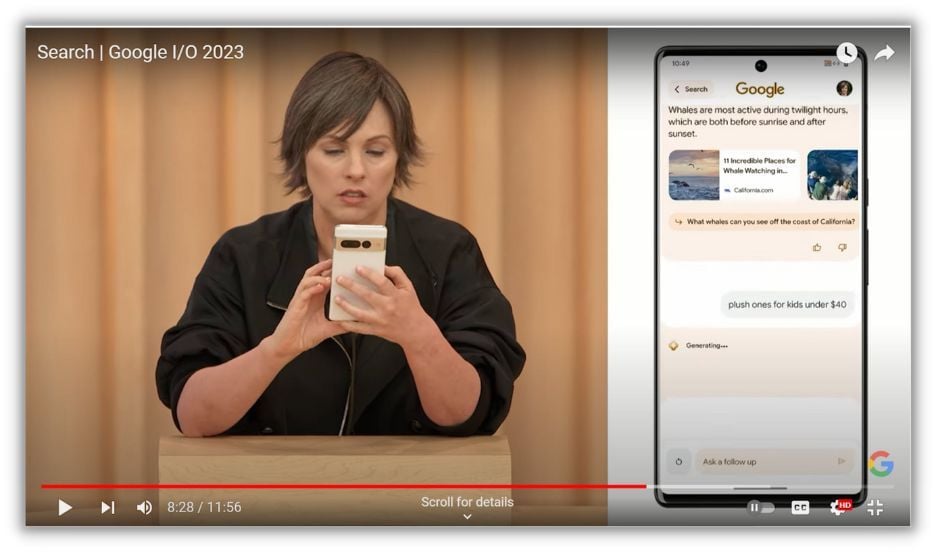
Source
In a standard search, Google wouldn’t know she wanted whale stuffed animals. But SGE’s AI understood the assignment because it carries context from previous searches. So a few moments after asking, Edwards saw a list of links to stores selling a variety of plush whale stuffed toys.
The bottom line: The fact that product links surfaced in the middle of that conversational search suggests a big opportunity for businesses. If you can optimize your content to show for these types of searches, you could potentially get more qualified traffic. So how can you do that? For now, Google is prioritizing “high-quality online sources,” writes Barry Schwartz on Search Engine Land. “Google is using many of the signals Google has had in place for decades to understand information quality,” he writes. This speaks to the importance of creating content that aligns with E-EAT and builds credibility for your site.
On the paid side, you’ll need to make adjustments for these more conversational searches. “These unique long-tailed searches are going to naturally make a case to use phrase and broad match keywords more actively in your account to pick up on these new searches,” said Mark Irvine, Director of Paid Media at SearchLab.
“Additionally, these new qualifiers in extra-long search queries increase the need to regularly monitor your search terms and add new negative keywords as these under-searched long-tail terms are likely to explode in the next few years.”
Vertical experiences
SGE is also reshaping vertical searches like shopping and finding local businesses—especially when those queries have multiple angles to them. This is where things get really interesting for businesses that advertise and sell online.
Here’s an example. You’ve decided to ditch the car and cycle to work. You don’t want just any bike, you need one good for your five-mile, hilly commute. SGE understands these parameters, searches the 38 million products in Google’s Shopping Graph, and delivers this result.
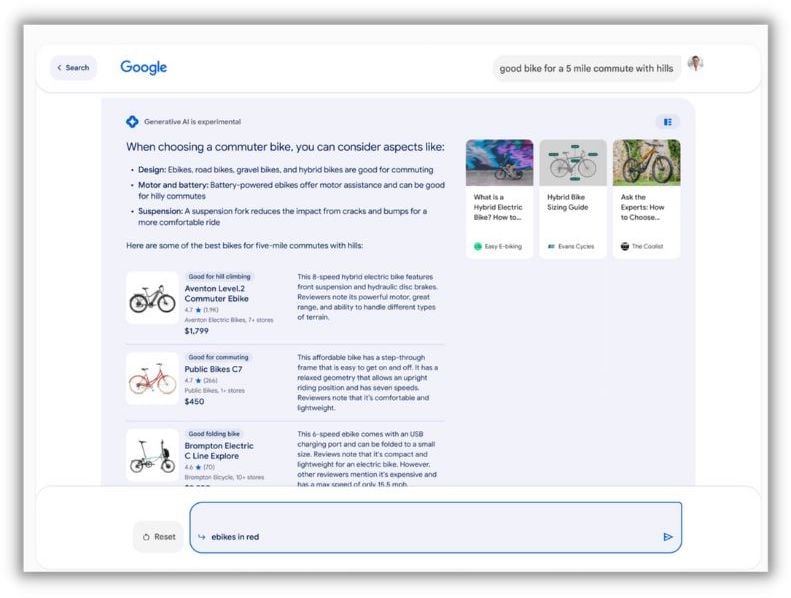
Source
Just like the vacation search, SGE generates an informational synopsis. This time, it’s a list of aspects you should consider for your new bike. If you want to refine the search to find red bikes that fit the bill, you ask a follow-up question.
Since this search is clearly commercial, SGE prepares a list of potential products. Each option includes an AI-generated description along with reviews, prices, and a thumbnail. Tap one and you’ll see a larger image plus stores selling that bike, their prices, and other helpful info like if they have it in stock.
The bottom line: Shopping suggestions are nothing new for Google. But how they’ll tie into the AI snapshot will be interesting to learn.
“Google’s made it pretty clear for retailers that Performance Max and shopping feeds will play an active role in this new search experience,” said Mark. “But other advertisers would be wise to prepare for more visual searches by adopting image extensions with their ads sooner rather than later.”
What does Google’s Search Generative Experience mean for businesses?
In their statement about SGE, Google said “we’ll test and evolve the ads experience as we learn more.” So it’s likely that more changes are coming.
For now, here are some of the implications of SGE for businesses.
A new place to show ads…
All Google says about ad location on SGE results is that “ads will continue to appear in dedicated ad slots throughout the page.” We do get a peek at one commercial query result. On it, ads are located across the top, ahead of the generative AI snapshot.
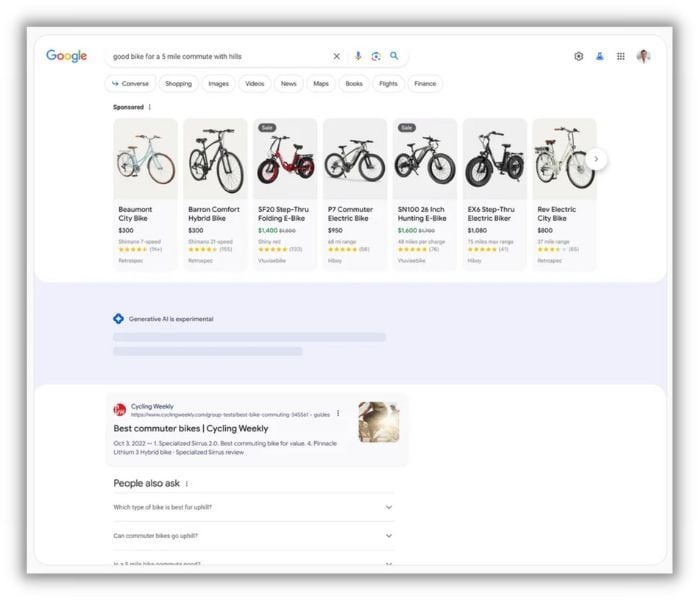
Source
For transparency, Google labels these links as “Sponsored.”
These aren’t new ad placements; they’re from existing campaigns, and advertisers are unable to opt-out at this time.
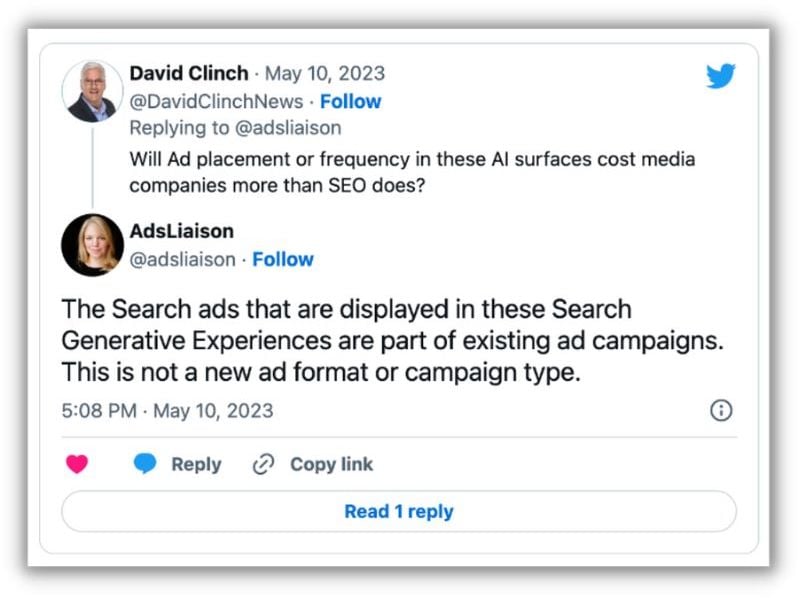
…But not a way to measure them
Tracking is also a bit of a black box at the moment. As mentioned, you can’t opt out of your ads showing up in SGE results. And you can’t see how ads perform on SGE SERPs separate from regular searches. All the data will be lumped together.
Potential loss of organic traffic
It’s possible that the new interface will throttle organic traffic by prioritizing AI-generated answers. The AI snapshot fills most of a mobile screen, forcing users to scroll to see the familiar 10 blue links.
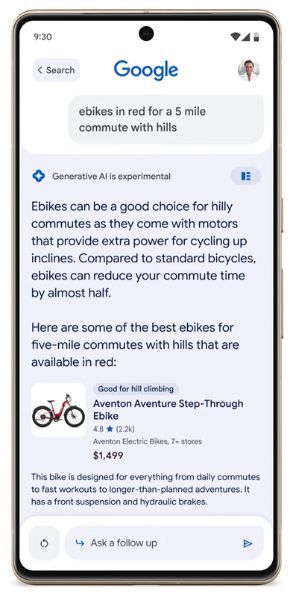
Source
The source links may help drive some traffic, but we don’t know how many clicks they’ll get. And there are no details yet on how to rank for these new features.
Plus, as Google aims to make SGE do the “heavy lifting” for searchers, there’s a fear that searchers may rely on results pulled from multiple sources and neatly packaged by Google rather than clicking through to the source websites.
“By doing the ‘heavy lifting’ itself, Google could leave these primary sources out of the equation.” writes Alex Kantrowitz for CMSWire.
AI-qualified traffic
On the upside, we see the potential for higher conversion rates for both SEO and paid traffic. If a shopper is able to learn and refine their search before clicking, they’ll likely be a higher intent buyer by the time they reach your site. In this case, SGE acts like a sales bot that helps qualify shoppers before they visit a store.
Google says they’ll monitor how SGE affects ad traffic and evolve as needed. Since 80% of Alphabet’s revenue comes from search ads, it’s a fair bet they’ll make sure advertisers are successful.
What can you do to prepare for SGE?
For now, the best thing you can do is sign up for Search Labs and opt in to the waitlist for SGE. Then, if you see a dramatic shift in results from a campaign, you can at least see if it’s a keyword that’s getting the SGE treatment. And of course, stay tuned to the WordStream blog and newsletter. We’ll make sure you’re up to date as Google evolves SGE.

